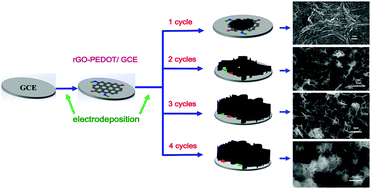当前位置:
X-MOL 学术
›
J. Mater. Chem. B
›
论文详情
Our official English website, www.x-mol.net, welcomes your
feedback! (Note: you will need to create a separate account there.)
A controllable honeycomb-like amorphous cobalt sulfide architecture directly grown on the reduced graphene oxide–poly(3,4-ethylenedioxythiophene) composite through electrodeposition for non-enzyme glucose sensing
Journal of Materials Chemistry B ( IF 6.1 ) Pub Date : 2017-10-23 00:00:00 , DOI: 10.1039/c7tb02482g Alan Meng 1, 2, 3, 4, 5 , Liying Sheng 3, 6, 7, 8, 9 , Kun Zhao 1, 2, 3, 4, 5 , Zhenjiang Li 3, 6, 7, 8, 9
Journal of Materials Chemistry B ( IF 6.1 ) Pub Date : 2017-10-23 00:00:00 , DOI: 10.1039/c7tb02482g Alan Meng 1, 2, 3, 4, 5 , Liying Sheng 3, 6, 7, 8, 9 , Kun Zhao 1, 2, 3, 4, 5 , Zhenjiang Li 3, 6, 7, 8, 9
Affiliation

|
A facile, controllable two-step electrodeposition synthesis route was developed, whereby a honeycomb-like amorphous cobalt sulfide architecture was obtained via direct growth on a glassy carbon electrode (GCE) functionalized by a reduced graphene oxide–poly(3,4-ethylenedioxythiophene) (rGO–PEDOT) composite film as an electrode for glucose detection. This electrodeposition method is binder-free, rapid, low-cost and preparation-controlled. The effects of the concentration ratio between CoCl2·6H2O and thiourea, deposition scanning rate and deposition cycles on glucose detection were investigated, and the optimum preparation conditions were determined. The characterization results indicated that the honeycomb-like cobalt sulfide architecture was formed by growing vertically amorphous CoxSy nanosheets with a thickness of about 20–50 nm on the rGO–PEDOT surface, and the morphology of cobalt sulfide could be controlled by regulating the deposition cycles. Under optimal conditions, the sensor exhibited a wide linear range from 0.2 to 1380 μM (R2 = 0.9976), a sensitivity of 113.46 μA mM−1 cm−2, a low detection limit of 0.079 μM and a response time of 3 s. This sensor also displayed good selectivity, reproducibility and repeatability for non-enzyme glucose sensing. More importantly, the sensor was successfully used to determine glucose in human blood serum samples, and the results were consistent with hospital test results.
中文翻译:

通过电沉积直接在还原的氧化石墨烯-聚(3,4-乙撑二氧噻吩)复合材料上生长的可控蜂窝状无定形硫化钴结构,用于非酶葡萄糖感测
开发了一种容易的,可控制的两步电沉积合成路线,从而通过在被还原的氧化石墨烯-聚(3,4-乙撑二氧噻吩)功能化的玻璃碳电极(GCE)上直接生长,获得蜂窝状无定形硫化钴结构。(rGO-PEDOT)复合膜作为葡萄糖检测电极。这种电沉积方法是无粘合剂,快速,低成本且可控制制备的。CoCl 2 ·6H 2之间的浓度比的影响研究了O和硫脲,葡萄糖检测的沉积扫描速率和沉积周期,并确定了最佳制备条件。表征结果表明,蜂窝状硫化钴结构是通过在rGO-PEDOT表面上生长厚度约20–50 nm的垂直无定形Co x S y纳米片而形成的,硫化钴的形态可以通过调节沉积周期。在最佳条件下,传感器的线性范围从0.2到1380μM(R 2 = 0.9976),灵敏度为113.46μAmM -1 cm -2,低检测限为0.079μM,响应时间为3 s。对于非酶葡萄糖感测,该传感器还显示出良好的选择性,可重复性和可重复性。更重要的是,该传感器成功地用于测定人血清样品中的葡萄糖,其结果与医院的测试结果一致。
更新日期:2017-11-08
中文翻译:

通过电沉积直接在还原的氧化石墨烯-聚(3,4-乙撑二氧噻吩)复合材料上生长的可控蜂窝状无定形硫化钴结构,用于非酶葡萄糖感测
开发了一种容易的,可控制的两步电沉积合成路线,从而通过在被还原的氧化石墨烯-聚(3,4-乙撑二氧噻吩)功能化的玻璃碳电极(GCE)上直接生长,获得蜂窝状无定形硫化钴结构。(rGO-PEDOT)复合膜作为葡萄糖检测电极。这种电沉积方法是无粘合剂,快速,低成本且可控制制备的。CoCl 2 ·6H 2之间的浓度比的影响研究了O和硫脲,葡萄糖检测的沉积扫描速率和沉积周期,并确定了最佳制备条件。表征结果表明,蜂窝状硫化钴结构是通过在rGO-PEDOT表面上生长厚度约20–50 nm的垂直无定形Co x S y纳米片而形成的,硫化钴的形态可以通过调节沉积周期。在最佳条件下,传感器的线性范围从0.2到1380μM(R 2 = 0.9976),灵敏度为113.46μAmM -1 cm -2,低检测限为0.079μM,响应时间为3 s。对于非酶葡萄糖感测,该传感器还显示出良好的选择性,可重复性和可重复性。更重要的是,该传感器成功地用于测定人血清样品中的葡萄糖,其结果与医院的测试结果一致。











































 京公网安备 11010802027423号
京公网安备 11010802027423号